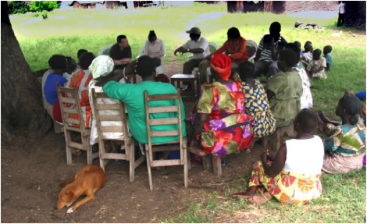Difference between revisions of "Focus Groups"
(Published from sandbox) |
(No difference)
|
Latest revision as of 00:30, 16 November 2013

In a focus group discussion, people from similar backgrounds or experiences (e.g. young women, young men, handicapped, elderly etc.) are brought together to discuss a specific topic related to water and sanitation issues. Focus groups can be used in Sustainable Sanitation and Water Management as an instrument to involve people in the decision making process. It gives specific user groups (in particular marginalised groups) the opportunity to express their interests and to incorporate the opinion of every stakeholder into the decision-making process. Focus groups are useful to apply in order to get a better understanding of differences in perspectives and of factors which influence opinion and behaviour regarding water and sanitation issues.
A skilled facilitator assembles representative groups from the community and creates an atmosphere where individuals feel free to express opinions openly on topics that concern them, e.g. that are related to water and sanitation (see also facilitators role). The facilitator is armed with key questions, but the conclusions emerge from the groups open discussions and lead to ideas for action.
| Advantages | Disadvantages |
|---|---|
| - To explore the range of opinions/views on a topic of interest - To explore meanings of survey findings that cannot be explained statistically |
- Findings are not always representative, as the sample can be very small - Findings are dependent on the composition of the group – a focus group is just as good as their participants |
The Differences between Focus Groups and Surveys
| Focus group | Survey |
|---|---|
| - Provide depth over breadth - Use small samples and the findings cannot be generalised |
- Provide breadth over depth - Require large samples and are more readily generalised |
Needed Material
A range of materials including tape recorders, if appropriate, and pictures to introduce topics for discussion, can be used – however, in practice, recording is often not needed and it is sufficient to note down salient points. Recording the discussion on tape has the advantage of being able to play it back and pick up salient points after the discussion is over. The disadvantage is that transcribing from tape takes a long time. Even then, important points may be missed if the tape recording is not accompanied by detailed notes on who the participants were, the order in which they spoke, and the non-verbal language which accompanied what was said. In any case, the important contents should be recorded in writing. It is ideal if one person is in charge for the recording and one person facilitates. It is often good to use a blackboard, coloured cards, or a flipchart to write down important points – like this, the participants can react if you misunderstood something.
Steps in Conducting a Focus Group

1. Clarify Purpose
The step clarifies the rationale for conducting a focus group, the issues and population of interest and identifies who is interested in the focus group results. This step is important in ensuring that the focus group technique is the appropriate methodology and will guide the development of the moderator’s guide and recruitment procedures. The following questions should be answered in this first step:
- Why conduct a focus group?
- Who are the stakeholders (see Analysis stakeholder analysis)?
- Who is the population of interest?
- What issues need to be explored?
- Are there other methods that could be applied and are maybe more appropriate? (e.g. problem tree analysis, locality mapping etc. – see exploring for an overview)
2. Assess Resources
This step explores the resources you have available so that you can design an evaluation that will be within your budget. Assessing your resources allows you to evaluate which resources you have available “in house” and which you will need to contract out. The evaluation of resources is crucial to ensuring the questions you want to address can be answered within the project’s budget (see also budget allocation and resource planning). The following questions should be answered in this first step:
- What external resources will you need?
- Which in-house resources can you make use of?
3. Decide on Methods and Procedures
There is no set rule for the number of focus group sessions needed. Two groups is generally the minimum. Ideally, you want enough groups to ensure that you have not missed any information. If after three or four groups, similar themes are emerging with no new themes coming up, additional groups may not be necessary.
Focus groups usually range in size from 8 to 12 participants. With regards to group size, it has been found that the number of ideas generated is not increased by increasing the number of focus group participants. The ability to obtain useful information will be enhanced if an environment is established in which participants feel comfortable and free to express their ideas and opinions. Depending on the issue under discussion, a more homogenous group may be preferable in order for participants to feel comfortable. The following questions should be answered in this first step:
- What is the total number of groups needed?
- What is the desired composition of the groups?
- Which are important stakeholders that should not be missed?
4. Write a Moderator’s Guide
A moderator’s guide is the outline of the discussion, which is to be carried out during the focus group. Writing the guide involves deciding on all topics to be discussed and organising them into a logical format for discussion. A moderator’s guide that is well-written and developed jointly by the moderator and stakeholders is crucial to ensuring that the moderator is able to collect the desired information from the participants. The questions included in the moderator’s guide will flow from the issues you want to explore and the questions you want to answer. The number of questions is usually limited to ten to twelve well-developed questions for a two-hour focus group. The number of questions is influenced by the topic, the specificity and detail required and the characteristics of the participants. Focus on the ‘need-to-know’ questions and leave the ‘nice-to-know’ questions as options if there is enough time remaining at the end. A moderator's guide is not a questionnaire, so it should not be cluttered with detailed questions. The questions should be general in nature with suggested probes that could be used to stimulate discussion and elicit details (see also facilitation).
5. Recruit Focus Group Participants
Participants must be carefully recruited and represent the target population that you are trying to study. The importance of recruiting focus group participants cannot be underestimated. Failing to carefully and thoughtfully recruit participants (e.g. also opinion leaders, decision makers etc.) can introduce a bias into the results which are obtained from the group. If the right people are not recruited for a focus group, the information generated may be useless (see selection of participants).
6. Logistics of the Focus Group
There are a number of activities and details to be organised and coordinated which will increase the effectiveness of the focus group. Provision of the proper physical location is mandatory. The location should be central, easy to find, and allow participants to feel comfortable and relaxed. Focus groups should be scheduled for times which are convenient for participants (e.g. after work). Refreshments, such as snacks and drinks should be provided to participants in an attempt to make them feel comfortable and make their experience as pleasant as possible (see also logistics).
7. Facilitate Focus Group
The moderator plays an integral role in the conduct of the focus group. While there is a prepared guide for the discussion, the moderator is essentially the ‘instrument’. The moderator’s role in facilitating the focus group involves:
- creating a supportive climate that encourages all participants to share their views
- building a rapport with participants
- covering important questions and topics from the prepared moderator’s guide
- facilitating interaction among group members
- interjecting probing comments, transitional questions and summaries
- determining how participants feel about ideas/opinions expressed by others
- managing time
8. Analyse Outcomes
Analysing the data consists of objectively reviewing the transcripts/notes and identifying the main points or themes, which answer the original evaluation questions. This step is important because it organises the information collected and summarises the information so that it can be interpreted. When an audiotape is used to record the focus group discussion alone, transcription of the data from the tapes is required. Regardless of whether you have a computer application or are doing the analysis by hand, there are two basic parts to the analysis of focus group data. The first part involves segregating and organising the data into logical and meaningful segments. These segments usually follow the moderators guide’s questions or subdivisions.
The second part in the analysis is interpretive and involves developing criteria for organising the data into useful groups (themes). This is sometimes referred to as coding. Transcripts are often not required if you are not working in a scientific environment. You can also uses your notes / flipcharts for analysing the data. In any case, it is recommendable to do the analysis as quickly as possible after the meeting, as your memory of the event is still fresh.
9. Interpret and Disseminate Focus Group Results
Interpreting the focus group results is done in order to answer the original questions that were posed for the evaluation. It allows you to draw conclusions. Interpreting the results of the focus group is one of the most crucial steps in the process of ensuring useful findings which accurately reflect the opinions and views of the participants involved and answer the original questions. It may be useful to discuss your interpretations with your colleagues to avoid biases.
10. Take Action!
Taking action refers to implementing the changes suggested by the results of your focus groups. It is important to take action and implement changes in order to make improvements to your program/service/product.
| To continue reading check out the complete guide, Focus Groups, on the SSWM website. |
Acknowledgements
- Stefanie Keller and Juri Lienert. Focus Groups. SSWM.
